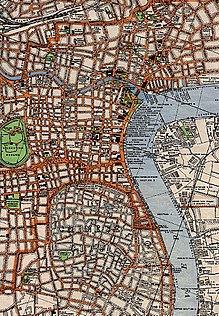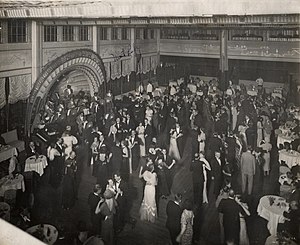
Shanghai is one of the four direct-administered municipalities of China. The city is located on the southern estuary of the Yangtze River, with the Huangpu River flowing through it. The population of the city proper is the third largest in the world, with around 29.2 million inhabitants in 2023, while the urban area is the most populous in China, with 39.3 million residents. As of 2018, the Greater Shanghai metropolitan area was estimated to produce a gross metropolitan product (nominal) of nearly 9.1 trillion RMB. Shanghai is one of the world's major centers for finance, business and economics, research, science and technology, manufacturing, transportation, tourism, and culture. The Port of Shanghai is the world's busiest container port.
Treaty ports were the port cities in China and Japan that were opened to foreign trade mainly by the unequal treaties forced upon them by Western powers, as well as cities in Korea opened up similarly by the Qing dynasty of China and the Empire of Japan.

The Treaty of Tientsin, also known as the Treaty of Tianjin, is a collective name for several unequal treaties signed at Tianjin in June 1858. The Qing dynasty, Russian Empire, Second French Empire, United Kingdom, and the United States were the parties involved. These treaties, counted by the Chinese among the unequal treaties, opened more Chinese ports to foreign trade, permitted foreign legations in the Chinese capital Beijing, allowed Christian missionary activity, and effectively legalized the import of opium. They ended the first phase of the Second Opium War, which had begun in 1856 and were ratified by the Emperor of China in the Convention of Peking in 1860, after the end of the war.
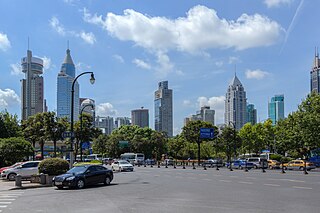
Huangpu District, makes up the eastern part of Shanghai's traditional urban core and is today the most central of Shanghai's 16 districts. Huangpu district is the seat of municipal government, includes key attractions such as The Bund and the Old City God Temple, as well as popular shopping districts such as Nanjing Road, Huaihai Road, and Xintiandi. The Huangpu District is one of the most densely populated urban districts in the world.

The Bund is a waterfront area and a protected historical district in central Shanghai. The area centers on a section of Zhongshan Road within the former Shanghai International Settlement, which runs along the western bank of the Huangpu River in the eastern part of Huangpu. The area along the river faces the modern skyscrapers of Lujiazui in Pudong. The Bund usually refers to the buildings and wharves on this section of the road, as well as some adjacent areas. This region has a significant European influence, with the style of many structures most comparable to that of European cities, particularly Gothic, Baroque, Neoclassical, Romanesque, Art Deco, and Renaissance architecture. Additionally, some of the city's top eateries are located there. From the 1860s to the 1930s, it was the rich and powerful center of the foreign establishment in Shanghai, operating as a legally protected treaty port.

The Battle of Shanghai was the first of the twenty-two major engagements fought between the National Revolutionary Army (NRA) of the Republic of China (ROC) and the Imperial Japanese Army (IJA) of the Empire of Japan at the beginning of the Second Sino-Japanese War. It lasted from August 13, 1937, to November 26, 1937, and was arguably the single largest and longest battle of the entire war, with it even regarded by some historians as the first battle of World War II. The Japanese eventually prevailed after over three months of extensive fighting on land, in the air and at sea. Both sides accused each other of using chemical weapons during the battle, with Japanese forces confirmed to have illegally deployed poison gas at least thirteen times. Historian Peter Harmsen stated that the battle "presaged urban combat as it was to be waged not just during the Second World War, but throughout the remainder of the twentieth century" and that it "signalled the totality of modern urban warfare". It has also been called "one of the most incredible defensive battles ever waged on this planet". It is considered to be the single largest urban battle prior to the Battle of Stalingrad.
The Green Gang was a Chinese secret society and criminal organization, which was prominent in criminal, social and political activity in Shanghai during the early to mid 20th century.

The January 28 incident or Shanghai incident was a conflict between the Republic of China and the Empire of Japan. It took place in the Shanghai International Settlement which was under international control. Japanese army officers, defying higher authorities, had provoked anti-Japanese demonstrations in the International Settlement following the Japanese invasion of Manchuria. The Japanese government sent militant ultranationalist Japanese Buddhist priests belonging to the Nichiren sect to Shanghai. The monks shouted anti-Chinese, pro-Japanese nationalist slogans in Shanghai, promoting Japanese rule over East Asia. In response, a Chinese mob formed killing one monk and injuring two. In response, the Japanese in Shanghai rioted and burned down a factory, killing two Chinese. Heavy fighting broke out, and China appealed with no success to the League of Nations. A truce was finally reached on May 5, calling for Japanese military withdrawal, and an end to Chinese boycotts of Japanese products. It is seen as the first example of a modern war waged in a large city between two heavily equipped armies and as a preview of what was to come during the Second World War.

The Shanghai International Settlement originated from the merger in the year 1863 of the British and American enclaves in Shanghai, in which British and American citizens would enjoy extraterritoriality and consular jurisdiction under the terms of unequal treaties agreed by both parties. These treaties were abrogated in 1943.
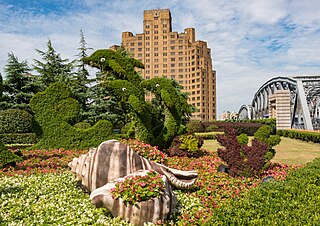
Huangpu Park is the name of the triangular stretch of green at the northern end of the Bund in Shanghai, the oldest and smallest park of the city. It is the site of the large Monument to the People's Heroes, commemorating those who helped to free China from foreign occupation, and of the Bund Historical Museum, which documents the history of the Bund in old photographs.

Foreign concessions in China were a group of concessions that existed during the late Imperial China and the Republic of China, which were governed and occupied by foreign powers, and are frequently associated with colonialism and imperialism.
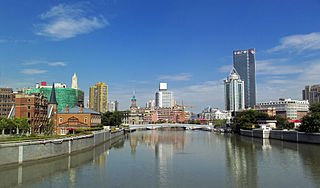
Suzhou Creek, also called the Wusong (Woosung) River, is a river that passes through the Shanghai city center. It is named after the neighboring city of Suzhou (Soochow), Jiangsu, the predominant settlement in this area prior to the rise of Shanghai as a metropolis.

The Shanghai French Concession was a foreign concession in Shanghai, China from 1849 until 1943, which progressively expanded in the late 19th and early 20th centuries. The concession came to an end in 1943, when Vichy France under German pressure signed it over to the pro-Japanese Reorganized National Government of China in Nanjing. For much of the 20th century, the area covered by the former French Concession remained the premier residential and retail district of Shanghai, and was also one of the centers of Catholicism in China. Despite re-development over the last few decades, the area retains a distinct character and is a popular tourist destination.

Edward Isaac Ezra was a wealthy Jewish businessman, who was the first member of the Shanghai Municipal Council who was actually born in China, and who was at one time "one of the wealthiest foreigners in Shanghai". According to one report, Ezra amassed a vast fortune estimated at from twenty to thirty million dollars primarily through the importation of opium, and successful real estate investment and management in early twentieth century Shanghai. Ezra was the largest stockholder and the managing director of Shanghai Hotels Ltd., and its major financier, and controlled such hotels as the Astor House Hotel in Shanghai.

Shanghailanders were foreign – principally European and American – settlers in the extraterritorial areas of Shanghai, China, between the 1842 Treaty of Nanjing and the mid-20th century.

The "century of humiliation" is a term used among the Sinosphere to describe the period in Chinese history beginning with the First Opium War in 1839, and ending in 1945 with China emerging out of the Second World War as one of the Big Four and established as a permanent member of the United Nations Security Council. Or alternately, ending in 1949 with the founding of the People's Republic of China. The century-long period is typified by the decline, defeat and political fragmentation of the Qing dynasty and the subsequent Republic of China, which led to demoralizing foreign intervention, annexation and subjugation of China by Western powers, Russia, and Japan.
The urban planning of Shanghai refers to various phases of planning and development of Shanghai, presently the largest city in China and one of the largest in the world. The topic is the focus of the city's Urban Planning Museum, located in People's Square beside City Hall.
The following is a timeline of the history of the city of Shanghai in China.

Yan'an Road is a road in Shanghai, a major east–west thoroughfare through the centre of the city. The modern Yan'an Road is in three sections, reflecting three connected streets which existed pre-1945: Avenue Edward VII, Avenue Foch, and the Great Western Road. The streets were joined together under a common name by the Republic of China government in 1945, then renamed in the early 1950s after the Chinese Communist Party took over Shanghai. The road is named after Yan'an, the Communist base during the Chinese Civil War.

The British Concession or Settlement was a foreign enclave in Shanghai within the Qing Empire which existed from around 1845 until its unification with the American area, located directly north of it across Suzhou Creek to form the Shanghai International Settlement in 1863.






